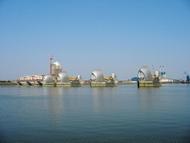Precautionary Adaptation
- By:
- Edward A. Reid Jr.
- Posted On:
- Nov 19, 2019 at 6:00 AM
- Category
- Climate Change
“The precautionary principle is the concept that establishes it is better to avoid or mitigate an action or policy that has the plausible potential, based on scientific analysis, to result in major or irreversible negative consequences to the environment or public even if the consequences of that activity are not conclusively known, with the burden of proof that it is not harmful falling on those proposing the action.” , New World Encyclopedia
The Precautionary Principle has been a tenet of UN climate change efforts since the United Nations Environmental Programme (UNEP) Rio Summit in 1992. It was one of the principal drivers of both the Kyoto Protocols and the Paris Climate Accords.
Climate alarmists have cited the principle as the basis for their demands for aggressive global mitigation efforts to reduce and eliminate anthropogenic CO2 emissions by some future date certain. However, their resort to the principle as justification for action has become less frequent as they have adopted the position that the consequences of anthropogenic emissions are “conclusively known”, since “the science is settled”. The models have spoken and “climategeddon” must be avoided at all costs. However, the developing nations appear less concerned about “climategeddon” than about economic development and the UN Green Climate Fund.
Others in the consensed climate science community have become concerned that the mitigation efforts agreed to in the Paris Accords are not aggressive enough to avoid significant adverse climate change impacts; and, that even those efforts are not being implemented consistent with national commitments. They have begun shifting emphasis from precautionary mitigation to what I refer to as precautionary adaptation.
The recent formation of the Global Commission on Adaptation is one effort to emphasize the need for adaptation and to plan for the diversion of funds to deal with perceived adaptation infrastructure needs. The Commission accepts the notion that climate change is a crisis requiring far greater response from the global community. It has identified the need for funding of $140 - 400 billion for adaptation. This is in addition to the $100 – 400 billion sought for the UN Green Climate Fund. So far, the nations expected to provide funding for these programs appear to view them as less urgent than the nations demanding the funding.
Precautionary adaptation is not a new phenomenon. The Netherlands has perhaps the oldest and most ambitious adaptation to sea level rise and storm surge in its Sea Wall. The country has not only protected its largely low-lying land mass, but also added approximately 12% to its land area which lies below the adjacent sea level. England has installed the Thames Barrier to manage storm surge in the upper Thames River.
New Orleans, Louisiana has installed a network of levies to control Mississippi River flooding and to contain storm surge. However, due to general land subsidence, these levies are sinking, reducing their effectiveness, as was demonstrated clearly during Hurricane Katrina. Funding had been provided to raise and reinforce the levies, but was diverted to fund other projects, to disastrous effect.
Numerous nations with exposures to the global oceans, particularly areas with historical exposure to hurricanes, typhoons and tsunamis are considering the construction of sea walls and other infrastructure projects to deal with what they believe will be inevitable future sea level rise and increasing storm frequency, magnitude and intensity. Others are investigating construction of dams and other alterations to riverbeds to deal with both projected increased floods and droughts.
However, against this background of climate change concern, infrastructure investment in areas prone to sea level rise and storm surge continues apace, increasing the financial exposure to storm damage.


